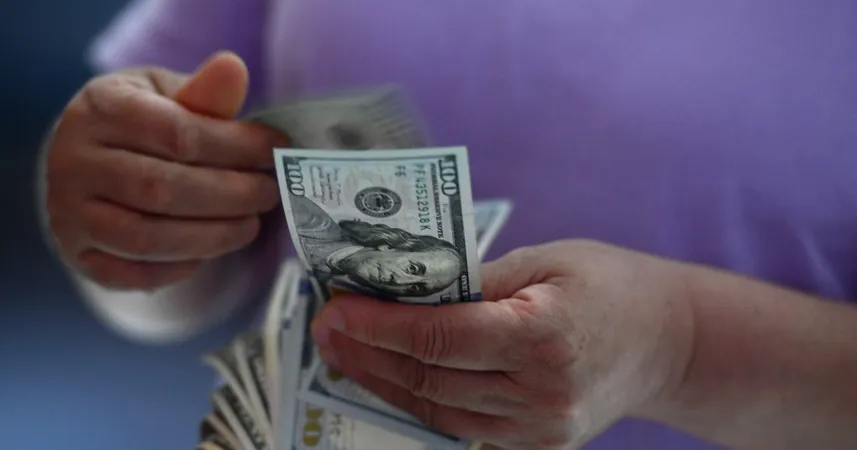
The Dollar's Dramatic Dive: What it Means for America and Your Wallet
2025-07-02
Author: Ling
In a shocking turn of events, the U.S. dollar has plummeted at its fastest rate since 1973, paving the way for drastic changes in the global economy — and potentially pinching your pocketbook.
Over the past six months, the dollar has dropped by more than 10% against a group of major currencies, hitting a three-year low. This decline is attributed to global investors losing confidence in the U.S. economy's ability to outperform others, sparked by tariffs and rising fiscal challenges.
Trump's Miscalculation on Tariffs
Interestingly, many — including members of President Trump's own Cabinet — believed that his tariff strategy would boost the dollar's value. The logic was simple: as Americans buy fewer foreign goods, other currencies would weaken against the dollar. However, the reality has been quite the opposite.
The weakened prospects for U.S. growth, partly fueled by these tariffs, have made U.S. debt less attractive to foreign investors. They are increasingly drawn to countries like Germany and Japan, where growth projections are much brighter.
Will a Weaker Dollar Help Exports?
In theory, a drop in the dollar makes American goods cheaper for foreign markets. But is that actually happening? The truth remains uncertain as U.S. firms scrambled to import more goods earlier this year, trying to beat the impending tariff hikes.
As second-quarter data rolls in, analysts caution that early figures may not accurately reflect true export growth, as companies adjust to the new economic landscape.
U.S. Travelers Feeling the Crunch
One immediate effect of a weaker dollar is the surge in costs for Americans traveling abroad. With the dollar losing its strength, vacations to popular destinations become pricier, making globe-trotting a less affordable luxury.
Inflation Worries Amidst Declining Purchasing Power
At the ground level, inflation and reduced purchasing power are looming threats for American consumers and businesses that continue to rely heavily on imports. Until the U.S. develops its own production capabilities at larger scales, rising costs for imported goods will shrink what Americans can buy.
Investor Sentiment Shifts: A Scary Trend?
Adding to the uncertainty, there's a growing trend: foreign investors are pulling back from U.S. financial assets at alarming rates. While U.S. stocks have soared back to record heights, in relative terms, they are lagging behind stocks from Europe and around the globe.
"America relies not just on foreign goods, but also on foreign capital to maintain its financial markets," warns Bob Elliott, chief investment officer at Unlimited Funds. A weaker dollar may drive foreign investors away just when their support is most needed.
A Call for Caution: Investors Diversify Away from the U.S.
Bank of America analysts have noticed a strategic shift among investors, as many are beginning to reallocate their investments towards more stable and familiar markets back home, particularly in Europe — signaling a lack of confidence in U.S. economic stability.
Is the Dollar in Serious Trouble?
Some experts argue that fears surrounding continued weakness of the dollar may be exaggerated. They believe that America's resilient markets and robust regulations will ultimately overcome this hurdle. A recent rally in the dollar, following strong labor market data and significant tax cuts, offers a glimmer of hope.
However, should U.S. growth falter further, the Federal Reserve may need to cut interest rates, thus exacerbating the dollar's decline and driving prices up even higher.
"We might be facing a doom loop here," warns investor Danny Dayan. While current inflation has been moderate, tariffs will inevitably increase prices, and a slumping dollar will only add to that pressure.



 Brasil (PT)
Brasil (PT)
 Canada (EN)
Canada (EN)
 Chile (ES)
Chile (ES)
 Česko (CS)
Česko (CS)
 대한민국 (KO)
대한민국 (KO)
 España (ES)
España (ES)
 France (FR)
France (FR)
 Hong Kong (EN)
Hong Kong (EN)
 Italia (IT)
Italia (IT)
 日本 (JA)
日本 (JA)
 Magyarország (HU)
Magyarország (HU)
 Norge (NO)
Norge (NO)
 Polska (PL)
Polska (PL)
 Schweiz (DE)
Schweiz (DE)
 Singapore (EN)
Singapore (EN)
 Sverige (SV)
Sverige (SV)
 Suomi (FI)
Suomi (FI)
 Türkiye (TR)
Türkiye (TR)
 الإمارات العربية المتحدة (AR)
الإمارات العربية المتحدة (AR)